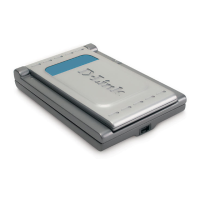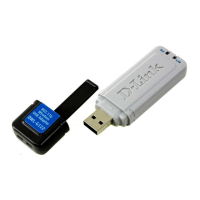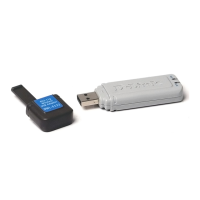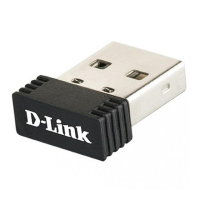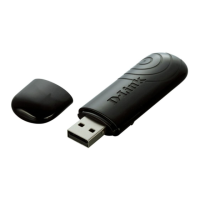
Do you have a question about the D-Link DWL-122 and is the answer not in the manual?
| Type | Wireless Adapter |
|---|---|
| Device Type | Network adapter |
| Form Factor | External |
| Interface (Bus) Type | USB |
| Connectivity Technology | Wireless |
| Standards | IEEE 802.11b |
| Data Link Protocol | IEEE 802.11b |
| Frequency Band | 2.4 GHz |
| Data Rates | 11 Mbps |
| Data Transfer Rate | 11 Mbps |
| Interface | USB |
| Antenna Type | Internal |
| Security | 64/128-bit WEP |
| Encryption Algorithm | WEP |
| Compliant Standards | CE |
| Operating Systems Supported | Windows 98, Windows ME, Windows 2000, Windows XP |
Lists the necessary hardware and software for the D-Link DWL-122 adapter.
Explains WPA security features and TKIP for enhanced wireless security.
Details the 802.1x authentication process for network intrusion defense.
Highlights 802.1x and WPA for improved wireless network security.
Defines WLAN and its benefits in various environments.
Provides guidelines to maximize wireless signal reception by considering placement and obstacles.
Step-by-step guide on physically connecting and safely disconnecting the USB adapter.
Instructions for utilizing the USB extension cable for flexible adapter placement.
Guides users through establishing a wireless network using an access point or router.
Explains how to configure a direct peer-to-peer wireless connection between computers.
Details IP addressing requirements for successful Ad Hoc network communication.
Instructions on launching and accessing the wireless adapter's configuration software.
Explains key fields and indicators within the utility like SSID, Signal Strength, and Tx Rate.
Details how to configure data encryption levels and authentication methods for secure connections.
Explains configuration options for key length and network IP addressing.
Covers advanced options such as Ad-Hoc channel, power mode, and packet parameters.
Guides users on scanning for available networks and managing connection profiles.
Instructions for creating new network profiles and modifying existing ones.
Step-by-step guide to set up the 802.1X security protocol for enhanced network authentication.
Lists and describes various EAP types used for 802.1X authentication.
Provides explanations for key terms related to 802.1X security protocols.
Explains domain name structure and TTLS Identity for EAP-TTLS authentication.
Details how to manage trusted Certificate Authorities for network authentication.
Step-by-step instructions for setting up WPA security for wireless network access.
Guide on setting up WPA-PSK for wireless security, noted as not requiring a RADIUS server.
Instructions for entering the WPA passphrase and accessing adapter information.
Steps to navigate the Macintosh OS to access system preferences for network settings.
Instructions to open the wireless adapter's configuration utility on a Mac.
Displays current network status and available wireless networks on the Macintosh utility.
Guides on connecting to, configuring, removing, or creating network profiles on a Mac.
Detailed steps for setting WEP encryption levels and entering the WEP string on a Mac.
Explains Power Save, Authentication modes, and World Mode settings on Macintosh.
Introduces the process of setting up a home or small office network using Windows XP.
Instructions for naming your computer and defining the workgroup for network identification.
Steps for creating a network setup disk and using it to configure other computers.
Details on how to use the network setup disk to run the wizard on additional computers.
Final steps to complete the network setup and restart the computer.
Step-by-step guide to name your computer and configure its network properties in Windows XP.
Instructions to verify the IP address assigned to the wireless adapter in Windows XP.
Guide on manually configuring static IP addresses for network devices.
Specifies how to input IP address, subnet mask, and DNS server addresses.
Demonstrates using the 'ping' command to test wireless network connectivity and response time.
Steps to verify if the DWL-122 drivers are installed correctly via Device Manager.
Discusses factors affecting wireless signal reception and range.
Provides solutions for establishing a wireless connection, including SSID and encryption checks.
Details the wireless standard (802.11b) and the function of diagnostic LEDs.
Specifies physical dimensions and supported data rates of the wireless adapter.
Details the operating voltage and supported encryption algorithms.
Provides specifications for the transmitter output power and receiver sensitivity.
Provides phone number and website for technical support in the United States.
Provides phone number and website for technical support in Canada.
Outlines the warranty terms for hardware and software components of the product.
Details conditions not covered by the warranty and the procedure for submitting a claim.
Specifies what is not covered by the warranty and the extent of D-Link's liability.
Defines legal disclaimers regarding warranties and product performance.
Information on copyright, trademarks, and CE compliance marking.
Details FCC statements, cautions, and radiation exposure guidelines for the device.
